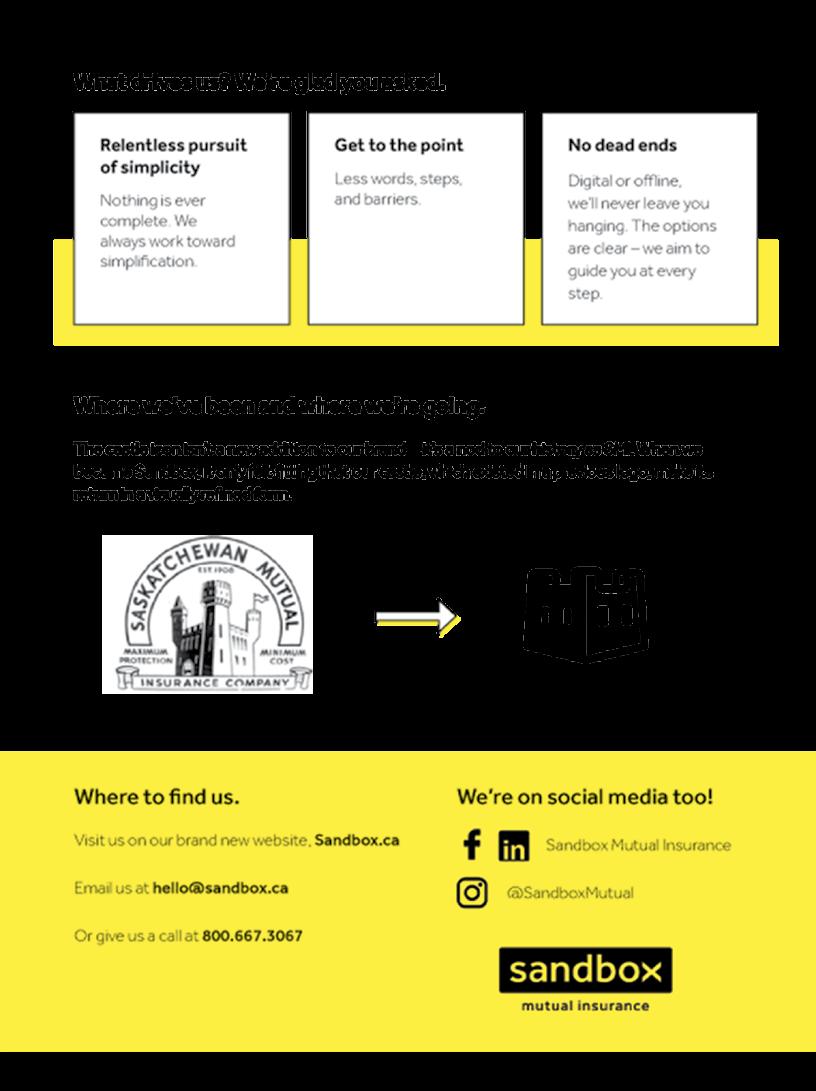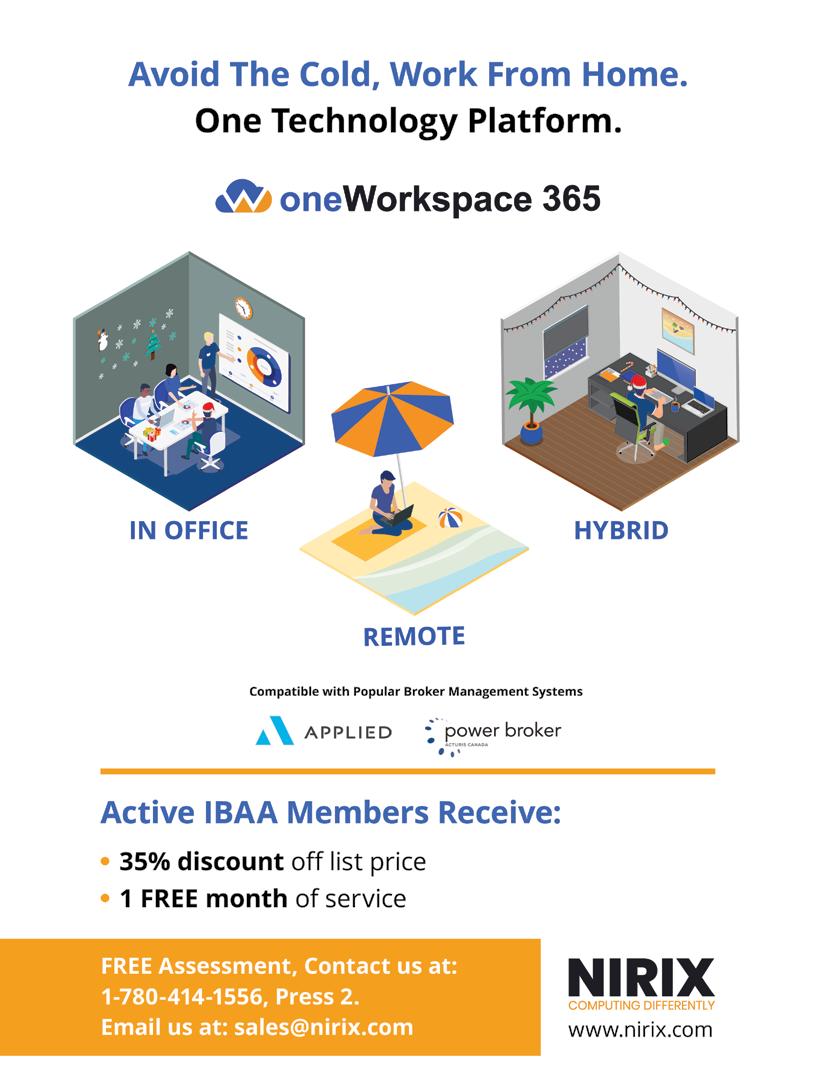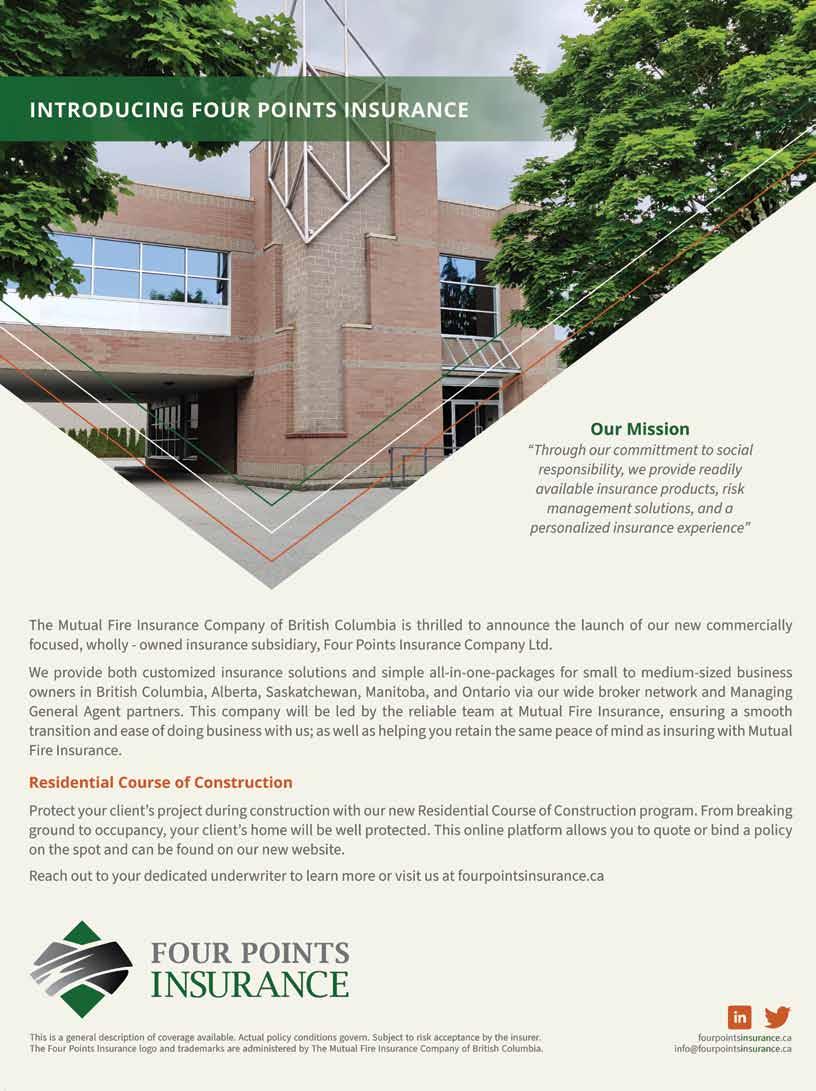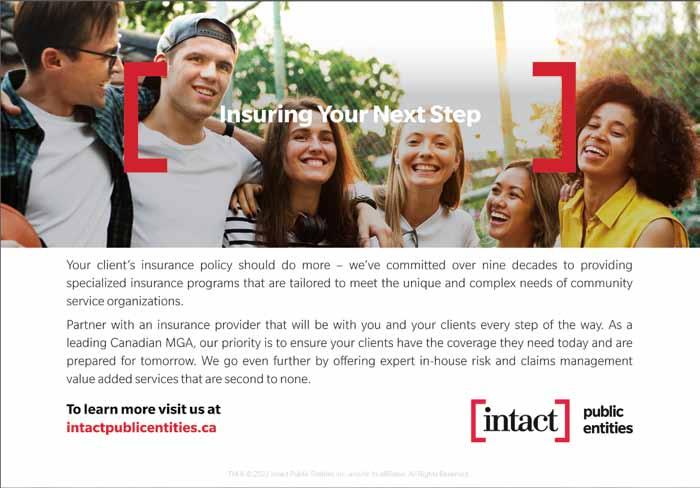





















Ifind it very fitting that this issue of Alberta Broker magazine is focused on tough client questions. Like most of you, I get my fair share of tough questions from clients when I am wearing my broker hat, and the answers do not come as easy as they may have in the past. Hard market conditions, inflation, rising premiums, more severe claims and CAT losses, unfamiliar working conditions … it may seem like we have more questions than answers ourselves. But this topic got me thinking about some of the tough questions I have been asked during my term as IBAA president—when I have to put personal opinions and business aside and look at what is in the best interest of our members as a whole.
I would say that the biggest ice breaker question I get when chatting with anyone in the insurance industry is pretty general: “What’s going on at the IBAA?” It is about as simple as a question can be, but it is one that I sometimes struggle to answer because I don’t know how much time I have to get into the nitty gritty of it! I have said it before, and I will likely say it a thousand more times before my term as president comes to an end, there is a
constant flow of communication between the IBAA office and the board, and a lot of the things that are discussed, debated, turned inside out and back again in numerous emails and conference calls among the board get summed up in one or two sentences in a report that is included in our AGM in April.
A previous article I wrote this year talked about how brokers need to get better at tooting our own horns and promoting ourselves to the consumers. I can say the same thing about the IBAA, but the association doesn’t necessarily need to be making headlines. In most cases, it is better to blend in, let our members be the stars and pick up our victories along the way. IBAA doesn’t have a lot of time to celebrate anyways. By the time we can feel good about accomplishing something in a battle that not a lot of people even knew we were fighting, we are on to the next issue.
I hope that most of you get our Brokerworks email that goes out on Fridays, where we try to sum up what we have been working on and where our focus is at any given time. I may be biased, but they are good, quick reads on a Friday afternoon and provide good insight into what

“By the time we can feel good about accomplishing something in a battle that not a lot of people even knew we were fighting, we are on to the next issue.”
the IBAA is working on. No one wants to work on Friday afternoon anyways, so I invite you to take a few minutes and give Brokerworks a read the next time you see it in your inbox. Another tough question I get as president is “ What are you guys doing about whatever a certain insurance market might be doing that one particular broker doesn’t like?” This is where we have to pick our battles. I have a lot of personal opinions on some of the actions that some of my particular insurer partners are doing/have done/are planning on doing, but my personal opinions don’t matter if I am alone. It starts to matter when we notice a swell and we hear from several members about the same issues that are worrisome to them and to the broker channel. This is why, if you have an issue, I would urge you to send an email to me, or George or whoever you are comfortable with on the board. Chances are, you are not the only one with the same concerns. It may not have much of an impact if you reach out to your business development rep at a market on your own, but if IBAA hears from 15 brokers about the same issue, we have the ammunition to contact that market on behalf of our members (also alleviating the fear of repercussion). Again, it is probably not public knowledge, but we have had a lot of success in this area in the past.
Recently, another tough question has come up: “What are your thoughts on the upcoming Alberta election and how could the outcome affect the insurance industry?” This is something that has never fallen off the priority list. We have already gotten an audience with some of the parties running for election and are actively pursuing meetings with the rest. We are working on a position paper specific to the auto segment of Alberta’s market and plan to present that when given the opportunity. We are also working with the Business Council of Alberta to present a unified message that will promote a sustainable insurance product for our province moving forward. Based on my conversations with various insurer partners, I know they are also in the process of preparing similar messaging. Finally, I would like to thank the broker members who have already reached out with their concerns and their offers to help the association with messaging and additional support. We will lean on your expertise when and where it is needed. The election will have an impact on the insurance industry one way or another, and we are mobilized and prepared to work with whoever gets elected in the next provincial election.


 By sara Hart, k c. & daVI d coW ley-saleg I o
By sara Hart, k c. & daVI d coW ley-saleg I o
Janice Thomson owned a renewable and convertible life insurance term policy from Ivari (the “term policy”) covering the life of her estranged husband with a death benefit of $1.3 million. When the term policy was due to expire, Ms. Thomson exercised an option to convert it to a universal life policy with a lower premium and a lower benefit of $400,000 (the “converted policy”). Ms. Thomson could cancel the converted policy during a 10-day cancellation period, rendering it void.
Ms. Thomson’s husband passed away unexpectedly during the cancellation period, at which point she purported to cancel the converted policy. Although Ms. Thomson claimed the higher benefit, Ivari denied her claim and would only pay the lower benefit.
In ruling on Ms. Thomson’s entitlement in Thomson v Ivari,1 Justice Feth of the Alberta Court of King’s
Bench heard a number of interesting arguments on key principles underlying insurance law, and some of his findings are discussed here.

Ivari had received Ms. Thomson’s application for conversion on December 1, 2017, and it issued the converted policy effective December 5, 2017. Ms. Thomson received the converted policy on December 12, 2017. The converted policy attached a one-page document (the “cancellation attachment”) that described Ms. Thomson’s right to return the converted policy to Ivari at any time within 10 days of receiving it such that “[t]his policy will be considered void as of the issue date if it is returned within those ten days.”
Ms. Thomson’s husband died on December 19, 2017. On December 20, 2017, Ms. Thomson sent a letter to Ivari asserting that she was cancelling the converted policy and requesting that the term policy be put back in place. Ivari refused, arguing that the term policy could not be reinstated after the conversion, that it could not be revived by the cancellation attachment and that the right to cancel had expired when the converted policy terminated on her husband’s death.
Ivari argued that the converted policy extinguished all of Ms. Thomson’s contractual rights as the policy owner because the death had terminated the converted policy and no contractual right to cancel could survive.


Justice Feth disagreed. He held: … Ivari’s position is predicated on the cancellation attachment forming part of the “policy.” While I accept that the cancellation attachment forms part of the insurance contract, I find that it is not part of the converted policy.
The termination clause expressly references the termination of the “policy,” not the “contract.” An insurance policy is not equivalent to an insurance contract.2
Justice Feth also relied on the distinction between “contract” and “policy” in the Insurance Act, 3 which, at s 642, states:
(1) An insurer entering into a contract must (a) issue a policy, and (b) furnish to the insured the policy and a copy of the insured’s application.
(2) Subject to subsection (3), the provisions in (a) the application, (b) the policy, (c) any document attached to the policy when issued, and (d) any amendment to the contract agreed on in writing after the policy is issued constitute the entire contract.
Justice Feth found that this distinction existed in the converted policy itself, which stated that “The entire contract between the owner [Ms. Thomson] and Ivari consists of this policy together with any endorsements, riders and other documents attached to it by Ivari on the issue date…” Accordingly, upon these and other bases, Justice Feth found that the cancellation attachment was one of the “other documents” referred to above and that it was therefore “part of the insurance contract but not part of the converted policy.” As such: “While the converted policy was terminated by the death of James Thomson, the contract was not. Consequently, all other contractual rights, including the right to cancel the converted policy, remained operative.”
Ivari also argued that a life insurance policy is a contract to pay a fixed amount when the insured event
(death) occurs and that it “matures” on the death of the life insured. Ivari asserted that, upon maturity, the policy owner has no remaining contractual rights, and the insurer must only pay the death benefit to the beneficiary.
Consistent with the distinction between the policy and the contract, Justice Feth disagreed that the parties to an insurance policy could not create contractual options or covenants that would survive maturity. Indeed, he referred to several contractual options and rights in the converted policy for the benefit of the insurer that survive maturity, such as the insurer’s ability to demand proof of the claim, the limitation period for commencing an action against the insurer for the recovery of insurance money and the insurer’s ability to adjust the death benefit if the life insured’s age or gender was misstated. As a result, maturity would not prevent Ms. Thomson from cancelling the converted policy after her husband’s death.
Ivari also argued that, once Ms. Thomson knew that her husband had died, cancelling the converted policy was no longer premised on fortuity, because she was exercising the option knowing the outcome of the insured event. Accordingly, with this knowledge and without the element of fortuity, Ivari argued that the fundamental principles of insurance contracts were violated.
In response, Justice Feth found that the issue turned on freedom of contract and the insurer’s choices in drafting. In particular, he observed that the cancellation clause stated “unequivocally” that Ms. Thomson could cancel “at any time within ten days after receipt” of that policy. No restrictions or conditions were mentioned, except for the 10-day time limit. Nothing was stipulated about the life insured still being alive
or the policy owner being unaware of the death of the life insured.” It was therefore up to the insurer to have protected itself with further conditions in the drafting process. According to the court, “Fortuity does not override freedom of contract. While insurance contracts are presumed not to cover a loss that is certain, that outcome can arise where ‘the words are very clear that the contrary is intended.”
Despite these and other arguments on additional issues, Justice Feth ultimately held that Ms. Thomson was entitled to the higher benefit of $1.3 million under the term policy.
As the decision in Ivari makes clear, an insurance policy is not the same as an insurance contract. In this case, the court relied upon rights defined in “other documents” to reach its finding. Perhaps more importantly, though, this decision affirms that insurers face a very uphill battle where they intend to convince a court to impose restrictions on insured’s rights (whether in a policy or a contract) where those restrictions are not in writing. Since insurers are the ones with the pen, courts hold them to their words—both the ones they include and the ones they leave out.
Sara.Hart@Dentons.com

David.Cowley-Salegio@Dentons.com

1 2022 ABKB 598 [IVARI].
2 IVARI at paras 24-25.
3 RSA 2000, c I-3 [Insurance Act].
Since insurers are the ones with the pen, courts hold them to their words— both the ones they include and the ones they leave out.
The member feature this month is a special one. Ravenhill Agencies Ltd., based in Edmonton, celebrated 40 amazing years in business at the end of 2022. To celebrate Ravenhill and their incredible team, we asked COO Caleb Maksymchuk to share a few words about who they are and where they started 40 years ago:

“We are so fortunate to celebrate our 40th year in business. Ray Callies, the founder of Ravenhill Agencies Ltd., started a one person operation back in 1982 after a career as a Chartered accountant. The name originated from Ray’s upbringing in the small town of Nordegg Alberta; a small mining town west of Rocky Mountain House. In the town and throughout his wilderness adventures there, he saw many ravens wandering about. He thought them a tough bird; one that would not give up, had good backbone, and a bit of relentlessness at times. This was the start of Raven Insurance.
When Ray went to register the name Raven, it was advised that this name existed along with a few other iterations. So he sat back and saw the vision of Nordegg in his mind with the mountains and hills in the background of the small mining town and came up with Ravenhill Agencies Ltd. Ray
started his insurance brokerage selling his first policies from his home office. Jim Harris, Ray‘s son in law, joined the firm shortly after and together they began to grow the business into the agency it is today. Ray became the financial accountant managing the firm, while Jim built the client base.
After eventually selling the firm to Jim, Ray continued to come into the office almost every day to grab lunch and visit, but more importantly he managed all aspects of the accounting for the firm. He was loved by all and even today some of his rules, best practices, and genuine care for clients are still employed. We are a third generation brokerage which seems to be on the rarer side of things in small to medium sized businesses. As a family owned business, we try our best to bring family to all aspects of the business.
Our team really is like family. Dave Wintoniak and Ray met as children when their parents curled together and has been with Ravehill for over 22 years now. Angie Granberg has been with the company 16 years and manages the Tofield operation. Caleb Maksymchuk is the second son-inlaw to join the firm.
Maintaining our core values of honesty, integrity , and service at all aspects of the company and adding a family lens to decision making is the secret sauce that has


afforded Ravenhill it’s continued success. We are not digital leaders in the industry but understand the need to use technology as a tool to offer greater service to our valued clients. We are very fortunate to have the growing team that we do. A big part of our success is owed to the team as they are the ones that treat our clients like part of the family. We continue to develop culture in the office through simple things like taking the time to talk as a group, utilizing technologies to interact among the offices, and regular 1:1 meetings.
One such ‘family focused’ event is the Home for Dinner cooking night at the Ronald McDonald House. We have been fortunate to have done this for quite a few years now and is a big event on our social calendar. The team is encouraged to get out in their communities to donate their time in any way, whether it be coaching, blood donations, or simply offering time where they can. We are currently in discussion with the University Hospital Foundation working on a new charitable initiative focused on specialized equipment. We are looking forward to launching this in the new year.”


Congratulations to the Ravenhill team, or should we say family? We can’t wait to see what the next 40 years have in store for you!



The commercial trucking market in Alberta is experiencing a significant increase in the number and cost of collisions on our roadways. This is creating insurance affordability challenges for some commercial truckers, particularly those operating single vehicles or small fleets.
This situation is not unique to Alberta. The commercial trucking sector across Canada is facing a myriad of converging issues that, if not addressed, could threaten the stability of the supply chains we rely on to deliver goods. The affordability of commercial trucking insurance has been on slow simmer for years, and insurers continue to see a significant increase in the size and cost of accidents on roadways in both Canada and the U.S.
In Alberta, many insurers have been experiencing claims costs exceeding collected premiums for consecutive years. This has led to premium cost pressures, particularly for single-vehicle or small fleet operations.

There are three different types of trucking operations in Alberta, each
with its own unique experience and risk profile for insurance:
Urban or local trucks, used predominantly within a single municipality or region of the province.
Long-haul operators that move goods throughout the province and other parts of Canada.
Trucks operated within and outside Canada to deliver goods internationally.
When determining premiums, insurers look to the combined ratio in each of these market segments. A combined ratio compares the amount an insurer pays in claims and expenses with the amount it collects in premiums. Combined ratios over 90% show a market under pressure.
Between 2016 to 2020, the combined ratio for urban and local trucks was 91%, however total claims paid increased by 201%. For long haul trucks, the combined ratio was 115%, while trucks operating internationally had a combined ratio of 126%.
The key factors contributing to these challenges are:
BY A ARON SUTHERLANDHigh turnover of experienced drivers
Hiring of new drivers who lack experience and access to adequate training and road safety programs
Significant fraud in the marketplace
A dramatic increase in large liability claims
Given these trends, Insurance Bureau of Canada (IBC), in partnership with member insurers, developed recommendations designed to improve driver training—both in terms of affordability and quality of education—to enhance the safety of roadways. IBC is also advocating for a national database of trucking insurance and claims information, so that insurers can verify a trucker’s driving history and fight fraud in the marketplace. Finally, IBC believes truckers deserve to have direct control of their employment records and driver experience confirmations to assist them in finding a job.
Unfortunately, Alberta’s Mandatory Entry Level Training (MELT)
program is inadequate, with only 120 hours of in-class and behind-the-wheel training. Other provincial programs provide over 600 hours to ensure drivers are adequately prepared.
In addition, a patchwork of accreditation standards means that instructors often lack the knowledge and experience required to prepare new drivers.
At $10,000 per driver, the cost for MELT is high compared to other jurisdictions, creating additional frustration and hardship for new drivers. Many other vocations such carpenters and electricians have a greater degree of training and accreditation than commercial truck drivers. That doesn’t make sense.
IBC believes the MELT program in Alberta should be enhanced to provide standardized curriculum for schools and professional trainers, with subsidies to help drivers receive this training at an affordable price. While it should remain mandatory where commercial trucking is a driver’s primary vocation, a separate framework should be considered for those who do not use their vehicle commercially, such a as farm-plated vehicles.

IBC is also recommending an update to the current national occupational standards for commercial vehicle operator (truck driver) and entry-level training requirements. Alberta’s current MELT training program should be aligned with other provinces, notably Quebec.
There should be continuing education for those in the trucking sector after entry-level training has been completed. Additional training
should be provided to better prepare drivers to Alberta’s unique terrain, and for what to do when hauling hazardous materials.
The challenges in Canada’s commercial trucking insurance market will not end overnight. All levels of government, the trucking sector and the insurance industry must come
 together to design and implement a new training framework in Canada.
together to design and implement a new training framework in Canada.

 By Tracy Harty
By Tracy Harty
Why do I keep hearing that the insurance companies are making record profits, yet my premiums continue to go up?
This question is no doubt a tough one! Not because we don’t have an answer, but because of the way that insurance company profits are reported in the news and because of what is missing from those news reports. Often, the news articles reporting on the insurance industry’s profits are based on one political party’s view against another political party’s actions—they are not the true picture. Some news articles take the entire P&C industry’s performance and report on the profits as a whole, and that’s it. A key piece that is often missing is the expense side of the equation. Insurance companies, just like any other business, have expenses—such as operating expenses and taxes—in addition to the expense of paying their claims. The higher the loss costs and expenses, the higher the premiums will need to be to break even or make a profit.
When reviewing “record profits” for the insurance industry, how do they compare to other industries? S&P 500
reports that the average net profit in Q4 of 2021 was 12%. Investopedia also states that a healthy average net profit ranges from 7 to 10%. So, the 8.7% profit margin for the Canadian P&C industry is right in line with other industries.
The advice on this question is twofold. First, find out how the insurance companies you represent are performing. Perhaps on a quarterly basis, dive into their numbers. What is the loss ratio they are experiencing and what is driving that loss ratio? Ask them what actuarial science and trends have changed to justify their rate increase.
Quite often something has changed in the risk itself that warrants an increase in premiums. It then becomes simply advising the client on how they can improve their risk variables. These include their driving record, claims performance and deductible options, as well as the coverage they carry and the loss prevention techniques they could implement.
Or is it that the insurance company is experiencing unfavorable results in a certain risk category or risk type? If this is the case, you may need to remind clients how insurance works and let them know that you have done the comparisons with your markets. In any case, be specific as to the reasons you are making your recommendation and that the increase in their premiums is not personal and is based on the primary function of insurance: the spread of risk.
Scan news reports to see what is being reported and keep abreast of the data and trends that are in the industry reports and publications available to brokers. Many of these reports and publications are also available to consumers, such as IBC’s 2022 Facts (For a list of several resources that can help arm you with facts to prepare informed responses, please see the sidebar on page 16.) By providing them with this information, you can begin to discuss the trends—both current and predicted—that impact premiums overall.
Currently what is trending and pushing claims costs up is the rate of inflation and supply chain issues. So how are these current trends impacting your client? If you can show them how, for example, the supply chain disruption causes higher business interruption expenses because of delays for your commercial clients, or how inflation has driven claims costs up overall, they very well may reach out for your advice the next time a news article on the industry’s profits appear. Or, better yet, be proactive—give them a call to see if they have any questions about it.
Why did my premiums go up when my vehicle is older, and I haven’t
This question is quite similar to the first one, but with a specific focus on automobile insurance. The same factors apply here: losses and expenses are still the key drivers, the cost of automobile claims is still increasing due to inflation and supply chain disruptions. You should be asking yourself, do your clients understand that there are common rating variables used to develop automobile insurance premiums—a driver’s convictions, accidents or claims—and these rating variables indicate the risk represented by them? Are they aware that all automobile rate increases must be filed with and approved by the AIRB and are based on actuarial data and an insurance company’s individual circumstances? If you haven’t already, you may need to review how the implementation of DCPD has impacted their premiums—if, in fact, it has. Some clients may have seen a slight increase, many have had a reduction or no change in premium at all. IBC’s data on “How Cars Measure Up” provides the details to help prepare brokers on advising those clients that have been affected with an increase because of their vehicle type.
Fuse Insurance’s Connor Lea offers this straightforward explanation, “Costs to repair vehicles are extremely
There is no shortage of questions that brokers receive from clients and prospects on a daily basis. While many can be answered easily on the spot, some can be a bit tougher and aren’t always so easy to answer. Here are the top tough questions faced by brokers and some advice on how to respond to them.
high right now. Including inflationary increases and parts shortages, those drive premiums up much more than your personal record.” And, when addressing the impact of the direct compensation for property damage (DCPD) regulation. Caleb Maksymchuk of Ravenhill Agencies informs his clients, “The introduction of DCPD makes for a more individualized rating according to the driver as well as to the vehicle. Higher valued vehicles are now having higher associated premiums while lower valued vehicles are seeing lower premiums overall.”
My property and contents are not worth that much, why am I paying premiums based on those values?
This is definitely a case of misunderstanding how the basis of settlements work in insurance policies. Your advice to clients could be:
Our policies have replacement cost coverage for property, wherever possible. Having this coverage means claims are settled based on the cost to repair, replace or rebuild the property. So, it is not a matter of what you can sell it for or what you paid for it. It is really about what would be the cost to replace or rebuild it today, at today’s costs. The values insured are based on what it costs to repair, replace or rebuild. We use a software program that is accepted by the insurance companies to determine the replacement value. Other valuation proof that is acceptable to the insurance companies is an appraisal of the property, the cost of which would be at your expense. My advice is to use the software that is accepted and ensure the information submitted is accurate.
I have “a friend” who had “this” happen to them; would I be covered if it happened to me?
This can definitely be a tough question to answer, since no two insurance policies are alike, and no two claim situations are identical.
Therefore, the advice on how to handle this question is to first verify that it is a “real” situation. It could be a masked attempt to find out if a loss that the client’s actual loss would be covered before they decide to report it. If this is the case, the advice is to let the client know that you, as their broker, cannot advise clients not to report a claim. It is a condition of their insurance policy that all losses are to be reported; you cannot advise them otherwise. It is also a requirement addressed in several sections under the General Insurance Council code of conduct and noncompliance will result in the broker being held subject to disciplinary proceedings. Brokers could be putting their license on the line by withholding claims from the insurer.
In a “real” situation there are circumstances where the broker is asked by their client if reporting a loss is “worth it.” This could be the case when there is loss or damage to the insured’s property only and where there is no chance there is a third party involved. However, the broker should stay away from advising on whether it is worth it or not when there is the slightest chance there could be a third party. Remember, when the client is describing the situation, it is their perception of the events that occurred, and the property involved, and may not be the complete picture. The caution for brokers is if they advise not to put in a claim, but then later on the client is served with notice of a pending lawsuit, or the client’s insurance company is contacted by a third party’s insurer with a subrogation claim, it can result in an error and omission claim against the broker.
Often clients will want to know, how will their premiums be affected if they proceed with reporting a loss. As mentioned, a broker cannot advise them not to report a loss, but they can discuss generally how claims impact their premiums. And the best time to have this discussion is at the time the policy is written and during the review
of their renewal, not when the client is actually experiencing a loss.
If the inquiry is truly about a friend who had a claim, and the client wants to ensure they would be covered if faced with the same situation, the advice to the client would be to let them know that all the details of a claim are carefully reviewed by an adjuster and it is the adjuster who would make the decision on whether a claim is covered or not. As a broker, your role is to advise on what coverages are included in their policy, but not whether a specific claim is covered. Generally speaking, you may want to assure them the intent is to offer coverage, if available, but as we know all policies contain limitations and exclusions so each situation should be assessed on its specific merits.
I don’t need that coverage, take it off my policy, because … a. [Business Interruption coverage] I would be back up and running right away if my business suffers a loss.
A positive outlook for sure, but it is often a misunderstood coverage. Advice in this instance could be to acknowledge the client’s assessment of their business and reassure them you just want to ensure they have also considered ways in which the business may not get back up and running right away. To assess, provide examples, particular to their business, and ask if they would still be in a comfortable financial position to absorb a loss of revenue if “x” happens, and if it takes “x months” to get up and running again. Basically, as their broker, you will want to find out what their threshold is for down time—both from the loss of revenue as well as from a loss of customers should they be inoperable for a period of time. It may take longer to return to pre-loss revenues if the business would have to gain new customers to replace lost ones.
Participants: Northbridge, Pafco, Lloyd’s, Swiss Re.

We’d like to say thank you to the exceptional insurance companies who work with us to deliver security and peace of mind to millions of Canadians. Your support and partnerships are greatly appreciated.

b. [cyber coverage] I have full anti-virus protection in place.
“The majority of cyber losses come from social engineering and compromised passwords, compared to viruses. As well, nearly all Canadian businesses faced a ransomware attack last year,” Lee shares.
In addition, your advice could be to provide some of the staggering statistics of the costs involved in recovering from a cyber incident that a policy covers such as fraud response, public relations, forensic and legal expenses, in addition to data recovery and extortion/ ransomware loss (check your cyber policies for specifics on the coverage).
c. [equipment breakdown coverage] I don’t own the building, so I have nothing to do with the boiler.
For this tough question, the advice should include that even though the loss or damage to a boiler is the responsibility of the building owner and damage from the boiler would also be the owner’s responsibility, the coverage goes beyond insuring boilers. This coverage applies to other machinery and equipment of the business from mechanical and electrical breakdown. Giving examples that are specific to your client’s business can help determine whether the coverage is of value to them.
Why did you pay their claim? they were fine—it was only a minor fender bender.
The client is advised when there is a payout on a claim, and many times they are surprised at the amounts or even that there was a payout at all. When a broker is presented with this question, the advice is to gently remind the client their insurance company has the authority and obligation, on the client’s behalf, to settle a claim fairly. That they are working in the best interest of their client as well as under the terms of the insurance contract. Often, injuries do
not appear at the time of the accident as adrenaline has kicked in. Reassure the client that the insurance company investigates and reviews all the information, including medical reports, before settling any claim.
I haven’t heard from anyone about my claim, what’s going on?
“Adjusters need time to process your claim. Patience will help here,” Lee advises his clients. And we agree. Reminding the client that claims take time and patience will ensure it is handled without skipping any important aspect of it. We all know that there are labor shortages around the globe—the insurance industry is no exception.
Let’s face it, brokers will always face some tough questions. The

best advice on how to respond to them is for brokers to firstly, anticipate them and then be prepared before you respond. A lot of that preparation is to drill down into the specifics—about that client, about their insurer. And there are many resources available to inform both brokers and consumers (some of which are listed in the box below). By advising your clients beyond a “standard” response, you show them how you truly are their trusted advisor.
TRACY HARTY
Professional Development Facilitator IBaa THarty@ibaa.ca

Insurance Bureau of c anada www.ibc.ca/ab
ibC 2022 facts book ibc.ca/ab/resources/industry-resources/ insurance-fact-book how Car insurance premiums Are Calculated ibc.ca/ab/auto/buying-auto-insurance/ how-auto-insurance-premiums dCpd
ibc.ca/ab/auto/dcpd how Cars Measure up ibc.ca/ab/auto/buying-auto-insurance/how-autoinsurance-premiums/how-cars-measure-up
To Sean at Economical Insurance, community is above all.
Which is why Jones Insurance asked Sean to participate in their Coldest Night of the Year initiative.




The initiative helped at-risk youth in New Brunswick receive support and shelter.
Now that’s a heartwarming story.
© 2022 Definity Financial Corporation. Intellectual property belongs to Definity Financial Corporation and/or its a liates. Economical is underwritten by Definity Insurance Company.











Supporting Community. Why? Because we’re in it for good.




In December 2021, CSIO’s Innovation and Emerging Technology (INNOTECH) advisory committee and Application Programming Interface (API) working groups finalized Java Script Object Notation (JSON) API data standards for personal automobile and habitational insurance policy inquiry. Not only was this a major milestone for the property and casualty (P&C) broker channel at the time, it also set the table for the INNOTECH leaders to continue advancing the digitization of our industry through API innovation in 2022.

Now that the year is coming to a close, let’s recap the INNOTECH API working groups’ main accomplishments
in 2022. But first, here’s a brief recap of INNOTECH and the value of APIs.
As you know, there are many types of broker management systems (BMS) and a wide variety of insurer systems. Ideally, insurers’ systems would be able to “communicate” with a BMS so that brokers could easily receive information related to their customers from their insurer partners. However, this isn’t always possible because the systems are “speaking a different language.” As a result, brokers who want customer information from insurers must usually resort to phoning them or accessing
the insurer’s portal, which can be cumbersome, time-consuming, and ultimately results in an inefficient process.
APIs are lines of code that enable systems to share information by speaking the same language. Insurer systems programmed with APIs can securely share client information with your BMS in real-time. JSON is the latest technology for API data interchange allowing larger amounts of information to move between systems faster than ever before. Think of brokers and their BMS as restaurant patrons and your insurer partners as all the chefs in the restaurant’s kitchen. In this example, JSON API Standards are the server that takes your order,

communicates with all the chefs in the kitchen and brings you the exact dish (client information) you wanted with a level of speed and efficiency that would not be possible if the patron had to enter the kitchen and try communicating their order to all the chefs on their own.
INNOTECH and its working groups: the people behind APIs
CSIO’s INNOTECH committee has a mandate to enhance the customer experience within the broker channel by driving digital advancement. One of the key solutions they’re focused on developing are industry API data standards. The following three INNOTECH working groups, that have broker, insurer and vendor representation, are made up of industry subject-matter experts dedicated to the continuous creation and evolution of APIs:
API Business Requirements: Examines the current broker workflow to establish business and data requirements necessary for building digital solutions that facilitate real-time processing.
API Technical Standards: Creates API solutions for the aforementioned business requirements.
API Security: Defines requirements for standardized authentication and authorization between broker, insurer and vendor systems.
API highlights from a successful year
INNOTECH and its working groups were responsible for many accomplishments for the industry in 2022. Here are some of their main accomplishments:
IBAC joins forces with CSIO for industry API development
The Insurance Brokers Association of Canada joined forces with CSIO and integrated the IBAC data exchange initiative into the INNOTECH API roadmap. IBAC provides the broker’s perspective when defining API business requirements.
Feb RUARY
API development roadmap finalized
INNOTECH advisory committee confirms the API use cases it will prioritize developing in 2022. A use case is the specific type of transaction that the API will allow an insurer’s system to share with a BMS.
M AR ch
API standards published in JSON for IRCA and CGL policy inquiry
The working groups publish API Standards using JSON for individually rated commercial automobile (IRCA) and commercial general liability (CGL) policy inquiry, the first industry standard for JSON in commercial lines.
ApRI l
API security working group publishes the industry’s first API security standard
Insurers and vendors can program the standard to help ensure brokers have adequate levels of security before they’re authenticated and authorized to log into insurers’ systems.
Dece M be R
INNOTECH API working groups completed the business requirements for 10 new use cases, thereby delivering on the 2022 API development roadmap
The team developed business requirements for 40 use cases, 10 use cases for each of the personal automobile, habitational insurance, IRCA and CGL lines of business: Get quote Create quote submission Request bind Policy amendment of details Addition of coverage/risk Deletion of coverage/risk Policy cancellation Create first notice of loss Get claims status Amend payment details
Congratulations to INNOTECH and the working groups on an excellent year! The industry looks forward to seeing how they will build on this year’s success to further accelerate the development of JSON API use cases in 2023.

Talk to your insurer and BMS vendor partners about programming API data standards into their systems so you can securely receive the customer information you need directly in your BMS, faster than ever before. You can learn more about all our different types of data standards and the advantages they bring by visiting the CSIO website.
SINCLAIRksinclair@csio.com
“Talk to your insurer and BMS vendor partners about programming API data standards into their systems so you can securely receive the customer information you need directly in your BMS, faster than ever before.”

Albertans frequently drive in provinces with no-fault automobile insurance (British Columbia, Saskatchewan, Manitoba, Ontario and Quebec), and should be made aware of the major differences between Alberta’s automobile insurance framework and a no-fault framework. Some Albertans do not understand the insurance implications of having an auto accident in a no-fault province and rely on you, their insurance broker, for advice.
In May 2021, B.C. adopted a no-fault auto insurance system, much like those in place for decades in Manitoba and Saskatchewan. In most cases, Albertans injured in auto accidents in no-fault provinces are not able to sue at-fault drivers for injuries. Instead, they claim enhanced no-fault accident benefits from their own insurer. The Alberta standard automobile policy provides that “Where an insured person suffers personal injury as a result of an accident occurring in a no-fault jurisdiction, the insurer agrees to pay … the amount that would be payable under the applicable laws of the no-fault jurisdiction as if the insured
person were a resident of the no-fault jurisdiction.”1
For example, an Albertan who cannot work due to injuries sustained in a car accident in B.C. is eligible for up to $105,5002 per year until able to return to work or until retirement instead of being limited to Alberta’s maximum disability benefit of $31,200 per year for two years.
There are also May 2021 changes in B.C. with respect to collision damage. Unlike Saskatchewan and Manitoba, where motorists are permitted to sue at-fault drivers for collision damage, B.C. has prohibited such actions. Instead, the Insurance Corporation of British Columbia’s (ICBC) Basic Vehicle Damage Coverage (BVDC) pays for not-at-fault damage on a B.C. driver’s own ICBC policy. Even though there is no equivalent BVDC coverage available on Alberta’s standard policy (Direct Compensation for Property Damage, or DCPD, only applies to Alberta accidents), ICBC expects that Alberta drivers will claim their own not-at-fault damage from their own insurer. The Superintendent of Insurance expects Alberta’s insurers to “read in” BVDC for B.C. collisions:

the Superintendent considers it to be an unfair act or practice for an insurer to deny such a loss because the notat-fault insured would be left without recourse, and Alberta insurers would neither pay at-fault nor not-at-fault property damage claims for B.C. collisions.

The Superintendent urges brokers to be informed about the differences between Alberta’s tort-based auto insurance and other provinces’ no-fault auto insurance, so brokers can make their customers aware of the implications. This is important especially for customers who are likely to drive in a no-fault province and when a customer reports a collision that happened in a no-fault province.
1 Section B, Subsection 2A—Supplemented benefits respecting accident occurring outside Alberta in a no-fault jurisdiction, SPF1 Standard Owner’s Automobile Policy
2 ICBC Guide to Enhanced Benefits: this this amount is indexed, and is as of April 1, 2022.
M ARK B RISSON Superintendent of Insurance province of albertaWhat happens if albertans are in an auto collision in a no-fault insurance province?
Once again, on behalf of the local Canadian insurance brokers that IBAC represents, we sincerely thank Lloyd’s for supporting our membership in the World Federation of Insurance Intermediaries (WFii). Because being part of something global, matters.

I had landed in a country I had never been to with two suitcases full of “only essential things” to start a life with my husband. It was nippy, and I stared at the wide roads on our way out of the airport, amazed at how empty they were as compared to the traffic back home in New Delhi.
In 2013, we had mustered enough courage to leave our families and secure jobs behind to start a life in a country that promised us better. Besides the evident anxiety on how and where to start from, we also knew we had it in us to find our rooting.

With the snow laden roads and after slipping on ice a few times, buying a vehicle soon became urgent. My husband spoke with an insurance agent over the phone for auto insurance and that’s when I heard terms like thirdparty liability, collision, comprehensive, etc., and I was struggling to keep up. We were also asked by our landlord to get renters insurance, something we were told wasn’t a choice. General liability insurance was still a less wide-spread and unexplored concept back home. We didn’t think to sue someone if they fell outside our doorstep, in fact the older “desi aunty” of the family would sarcastically retort, “Would be nice if the floor moved out of your way?” (We also didn’t know better than mindlessly honking at a fellow driver to say hello or move over or watch out! Something I truly do not miss.)
Time flew by as I tried hard to find a job, and my corporate training experience from our home country didn’t count for much. Quickly, I realized that I would need to embrace the career choices in front of me. The insurance industry chose me when one day I got a call from a recruiter who asked if I would be willing to study for the level 1 insurance exam—a licensing requirement, he said, in order to sell insurance and secure a job as a broker or agent. I can tell you that the exam was challenging, but also that the knowledge I gained was highly functional and useful. I aced my exam and knew this was where I would thrive. Fast forward to today where after completing my CIP, I am on a journey to earn the CRM designation and I know I will not stop after that either.
As my flight landed at the Edmonton International Airport on a mid-November evening, I peered outside my window and saw white swirls on the ground dancing in the wind. I did not understand at first and then with a gasp, I had a happy realization that it was snow. Snow! I had never experienced snow before and zipped up my jacket higher in anticipation.
Over the last eight years in the insurance industry, I have thoroughly enjoyed the challenges that came with each day. Working with some of the finest minds, brokers and underwriters—who are very bright, driven and talented professionals—has been an enriching experience. The immense and unstoppable learning, following the everchanging, dynamic market landscape and being a propagator of insurance is rewarding to say the least.
Like many essential sectors, the insurance industry has been working hard during last few tumultuous years due to COVID-19. The Canadian insurance market has remained resilient amid the chaos. That said, it is important, now more than ever, to educate consumers on insurance and help them navigate the insurance buying process—ensuring they understand the value of insurance while being considerate on not overloading them with information that might send them running in the opposite direction.
I have been an advocate of how important it is to carry the right kind of insurance, with adequate limits and coverages, and would end up talking about it even at a neighbour’s BBQ. My mentor in the industry one day asked me to consider joining PYIB, and I am grateful I did. Being a part of the PYIB board has enabled me to do what I am passionate about. It has provided me opportunities to reach out to new
and young Albertans to help them understand, and not be intimidated by, insurance as a career.
PYIB adds value to the broker industry by making it a priority to

feel insurance industry is demanding and there is a lot to learn, you are not mistaken! But what you should know is that it is very rewarding, the learning never stops—even for
promote insurance as a profession by attending career fairs for postsecondary education, sponsoring scholarships and building ties with risk management clubs at some of the province’s universities and colleges. We have fun networking events throughout the year to help foster better relationships between brokers and our insurance company partners.
Today, what I can tell all those new immigrants, like I once was, that if you

experienced brokers—and that is exactly why it keeps us on our toes and makes our day exciting. This industry’s demonstration of valuing their people and encouraging work-life balance continues to be unsurpassed.

i can tell you that the exam was challenging, but also that the knowledge i gained was highly functional and useful. i aced my exam and knew this was where i would thrive.

One recurring theme seen by insurance brokers E&O claim handlers is the problem created by a broker’s recommendation that a particular claim not be submitted to all potentially responsible carriers. An agent or broker who does an excellent job in location and placement of policies, later undoes all his or her good work by making assumptions about coverage for an occurrence or potential occurrence when one finally happens.
This is understandable. Insurance brokers, like everyone else, want to save themselves and their clients unnecessary work that seems unlikely to produce tangible results. A good broker wants to get to a productive solution rather than wasting valuable time when he or she perceives that there is no coverage.
In the simplest example of where good intentions can go wrong, consider a claim where, for whatever reason, a homeowner’s policy does not carry sewer backup coverage. When the client calls to report the mess in his basement, the broker has two choices. First, the broker can advise the client that, unfortunately, his policy does not cover sewer backup and ask if he’d like to add the coverage for the future. Second, the broker can advise
about the availability of the coverage but go ahead and submit the claim to the carrier anyway. In truth, there are many reasons why the coverage may not have been on the policy, some of which may lead the carrier to reform the policy to include the coverage. Further, there are some causes of sewer backup that some carriers may consider to be covered occurrences even absent the specific coverage. Imagine the client’s reaction when his neighbor’s claim is covered, and his is not. That reaction could lead to an E&O claim that could have been avoided merely by reporting the claim to the carrier. More typically, the failure to report claims scenario is a bit more complex. One example is a claim against an employer by its recently fired employee, which the employer’s insurance broker submits only to the employment practices liability carrier, and not to the general liability (GL) carrier. In fact, the GL carrier might have obligations regarding defamation allegations against the employer and failing to submit the claim to the GL carrier could lead to an E&O claim. Another example is part of a load falling from a truck and causing property damage. Would the allegations that the trucking company failed to properly train and supervise the employees who loaded the truck be excluded by the GL policy’s auto
exclusion? This is a determination that should be made by the GL carrier and not by the insurance broker. The better practice is to submit the claim both to the business auto and to the GL carrier.
One group of carriers that should always be included among those to which claims are submitted is excess and umbrella carriers. Even if it appears, at first blush, that the underlying policy limits are more than adequate, it is good practice to notify these carriers along with the primary carriers. Later, should the claim develop such that upper layers might be involved, any successful late notice defense available to excess/ umbrella P&C carriers could result in a successful E&O claim against the broker who didn’t report the claims to all the carriers involved.
In many cases the broker’s initial reaction is correct: There is no coverage available to the client. Nevertheless, this is not the broker’s determination to make. While a policy may have lapsed or been cancelled, if a broker reports a loss under that policy, the carrier in question typically has a statutory or regulatory obligation to review the matter and make a coverage determination. While rules may differ, all carriers are obligated to make a timely coverage determination and to provide timely notice of that determination to the entity making the
claim for coverage. Failure to make the timely determination or provide timely notice of the determination may affect a carrier’s ability to deny coverage, even on a policy that is no longer in effect.
This is, admittedly, not a strong position, as it relies on the remote possibility that a carrier may make an unlikely mistake or favorable determination in handling the claim. Still, from an E&O perspective, getting the claim covered lessens the possibility of facing an E&O claim down the road. In fact, the mere effort of submitting the claim for the carrier’s consideration could provide an important avenue of defense should an E&O claim arise.
There are obvious situations where it makes no sense to report a claim. If your client has driven his only car away on vacation and his house burns down while he is away, presenting a claim to his auto carrier would be frivolous in most cases. However, this author suggests that brokers should err on the side of reporting to too many carriers rather than too few.

Finally, there is the true E&O situation, where the lack of coverage seemingly arises from brokerage error, such as misplacing and then failing to submit an application for coverage. In such cases, you should immediately report the situation to your E&O carrier and seek your carrier’s advice for handling the situation. You should not undertake to explain the situation to the “would be” carrier hoping for ex gratia consideration of your client’s claim, as such a request might be considered an admission that breaches your E&O policy’s cooperation clause. Remember that your E&O carrier deals with similar situations daily and will work with you to resolve the situation in the best way possible.
In sum, undertaking to assist your clients in reporting claims is not a duty to be taken lightly. In fact, while representing good customer service, it is typically not a duty the law requires an insurance broker to perform. However, if you choose to provide this service to your clients, you must report any claim
to all reasonably relevant carriers and especially to all excess and umbrella carriers. Err on the side of reporting. The best practice is to follow up by sending your client a letter setting forth the list of carriers and policy numbers under which the claim has been reported. If the client believes the claim should additionally be reported to any other carriers, he should advise the broker immediately. Advise the client that he should be hearing from each of the carriers shortly and he should feel free to follow up with the brokerage if he does not hear from one or more carriers.
Finally, you should advise your client that the brokerage is not involved in the claim process of any carrier, and any questions about any carrier’s process must be addressed to that carrier.
© 2021 Swiss Re. All rights reserved. Reprinted with permission. The material contained herein is for informational purposes only and is not intended as legal or other professional advice. Please procure the appropriate legal or other professional advice and services to address your individual needs and circumstances.
As the new president of the Insurance Brokers Association of Canada (IBAC), I’d like to talk about who we are and what we do. I know for myself that until I became a director for IBAC, I was not fully aware of the different facets of the organization and how IBAC has been working to promote and protect the broker channel for over 100 years.
IBAC is a national organization that represents P&C insurance brokers through our 11 member associations. As a member of your provincial broker association, you benefit from IBAC’s activities in several ways.


IBAC has a solid reputation as a responsible stakeholder and our input is respected throughout government and the insurance industry. That is because we are the national voice of brokers who are trusted small-business professionals that contribute significant economic and social benefits to their communities. With the strength of over 38,000 P&C insurance brokers, we leverage your collective voice to ensure the broker perspective is heard at the highest levels.
Our core advocacy issue is the federal Bank Act, which legislates the separation of banking and insurance. We focus on the important provisions that prohibit banks from selling insurance at the point of granting credit and protect consumers from potential exposure to high-pressure sales tactics or coercive tied selling when they are securing a loan or mortgage.
We have been successful in defending these provisions against ongoing pressure from the big banks who are interested in increasing their insurance presence, which would effectively limit competition and encroach on brokers’ market share. We continue to keep an eye on all disruptors that could negatively impact the broker distribution channel and the consumers we serve.
IBAC also leverages our influence to raise awareness on important issues and contribute to the development of stronger social and economic policy. For example, our “Big If” campaign helps to educate Canadians about the risks of natural disasters and our sponsorship of National Safe Driving Week draws attention to the dangers of distracted driving. More recently, we have been advancing industry and broker priorities as the federal government moves to create a national flood insurance program for high-risk properties. We are also advocating for improved flood mapping and better ways to limit the impact of severe weather events through the development of a National Adaptation Strategy.
The largest display of collective strength is our annual “Hill Day,” when brokers from across Canada converge on Parliament Hill in a sea of magenta—a visible force promoting our key messages with the federal government. Through IBAC, insurance brokers are well recognized and strongly supported in Ottawa.
Often a solution can be found just by bringing people together.
Take technology, for example. IBAC spearheaded the data exchange (DX) initiative to bring together brokers, insurers and broker management system vendors to find ways to improve broker connectivity. We have made a great deal of progress on this complex issue and we are now merging our efforts with CSIO to achieve results even more quickly.
IBAC also brings together all member associations for productive discussions on areas of common concern. We brainstorm ideas and develop cohesive strategies on everything from education to regulator initiatives to communications and member relations. And why re-invent the wheel? A sister organization may have already tackled a problem and can share their ideas and best practices, saving everyone time and money.
Through your member association, you are part of the whole community of brokers. We are stronger together. This unity is best represented by our iconic magenta “Bipper,” which was created in 1988 (updated in 2018) and has become a widely recognized symbol of trust and integrity.
When you display the Bipper on your signs and website, it conveys the important message that you are a trusted professional who provides unbiased advice and choice and stands up for your clients. When you wear a Bipper pin, you are recognized as an insurance professional—not only by people in the insurance industry, but also by your local politicians, community leaders and the general public.
Our new strategic plan will continue to strengthen and support the broker profession with an eye to some of the emerging challenges.
For example, we are addressing the issue of talent acquisition and retention with a new advertising campaign that aims to elevate the broker profession and attract new people to our industry.

We are also actively engaged in the Canadian Insurance Services Regulatory Organization’s initiative to create a common core curriculum for entry-level broker licensing.
Brokers are at the heart of everything we do. I invite you to share

your thoughts—please reach out to me at linda.dolan@alportinsurance.ca or look for me at one of your upcoming conventions or events. And follow us on Twitter @IBACanada to stay connected.
 L INDA D OLAN President IBac ibac@ibac.ca
L INDA D OLAN President IBac ibac@ibac.ca
The fall/winter season at the IBAA office has been packed with convention planning, implementing a new association management system, advocacy and the continued evolution of our professional development (PD) department.
The excitement of election preparation has kept our advocacy team quite occupied the past few months. Their ongoing goal is to ensure that broker concerns are front and centre as policymakers develop platforms and politicians hit the campaign trail. If you’d like to keep up with our latest advocacy efforts, email cwilliamson@ibaa.ca to be added to our Brokerworks mailing list. Brokerworks is a once weekly email message from our energetic CEO, George Hodgson, full of advocacy updates, industry news, educational tidbits and more. It’s the best way to stay up to date on what we’re doing to keep your concerns visible.
Our IBAA professional development department, led by manager Zara Heather, has also been hard at work shaking up old systems and developing new internal processes to ensure you’re getting the most out of your IBAA education. They’re looking to make real and lasting change in the
way you get your continuing education credits from IBAA. But they can’t do that without input from you. Only you can tell us how you learn best, what times suit your busy schedules, what sort of topics you’d like covered, where the training gaps are in your office, etc. Connect with Zara and her team by emailing education@ibaa.ca if you’d like to influence the way you learn.
We heard from you that there was a need for a program that provides training for someone new to a brokerage to reduce the training time necessary in the branch. As a result, we are in the process of creating a program called the Broker 101 series, tailored specifically for those new to the insurance industry. If you have staff who have recently obtained their license and now require specific industry training that helps them progress their knowledge quickly from entry- to intermediate level, this course is designed for them.
The Broker 101 series will consist of eight modules that are meant to compliment what is already provided by the Canadian Accredited Insurance Broker program. The learner will tackle important topics such as how insurance works, how to deliver the ultimate customer experience, the broker’s legal duties, dealing with demanding clients, risk management, building a book of business, choosing the right products to sell, the claims process and more.
The course will be delivered as a selfdirected program that includes videos and activities for the learner to practice what they learn. It will be available 24/7 and done at the learner’s own pace. The series will be launching early 2023. To learn more about Broker 101 or to connect with our amazing PD department, email education@ibaa.ca.
Not to be beaten by education and advocacy, our convention team has also been working overtime the last few months on preparations for the 2023 IBAA convention. We are beyond excited to see you all in person again for a week of innovation and inspiration at the beautiful Fairmont Banff Springs from May 7-10. Dig out your fedoras and don some sequins and sparkle, it’s going to be a roaring good time. Register today by visiting ibaa.ca or by contacting our team at communications@ibaa.ca.
Finally, however you choose to celebrate, we hope your holiday season is filled with joy and love. In order to ensure our staff has enough time to spend with their loved ones, our offices will be closed from the afternoon of December 23 to January 3.
Thank you for being part of our amazing community. We look forward to connecting with you in the New Year!
April 20-22, 2023 TCU Place, Saskatoon, SK
Dr. Roberta Bondar – Canadian astronaut, renowned neurologist and scientific researcher

SGI CANADA was built on rock solid relationships with brokers. Let’s strengthen those bonds today, tomorrow, together! Registration is open for our partners. I hope to see you there!

- Penny McCune, President and CEO, SGI CANADA partners.sgicanada.ca

